Directive Letter
Subject: Directive - [Briefly state the purpose of the directive]
Dear [Recipient's Name],
I hope this letter finds you well. The purpose of this directive is to outline a specific course of action or provide guidance on a particular matter. It is important that you and your team adhere to the instructions provided herein to ensure a cohesive and effective approach.
1. Background/Context:
[Provide a brief overview of the background or context that necessitates the directive. This will help the recipient understand the reasons behind the directive.]
2. Objective:
[Clearly state the objective(s) or outcome(s) that the directive aims to achieve. Be specific and measurable if possible.]
3. Directive Details:
[Present the specific actions or steps that need to be taken to fulfill the objective(s). Provide clear instructions and expectations. You may use bullet points for clarity.]
4. Timeline:
[Indicate the timeline or deadline for implementing the directive. If there are specific milestones or interim deadlines, mention them here.]
5. Resources and Support:
[Specify any resources, tools, or support available to assist in the implementation of the directive. This may include personnel, budget, equipment, or other relevant resources.]
6. Reporting and Accountability:
[Outline any reporting requirements or mechanisms for monitoring progress and ensuring accountability. Specify whom the recipient should report to and how frequently.]
7. Communication:
[Specify how the directive should be communicated to the relevant stakeholders, both within and outside the recipient's team or department.]
8. Review and Follow-Up:
[State whether a review or follow-up meeting will be scheduled to assess the progress and outcomes of the directive. If applicable, provide details on when and how the review or follow-up will take place.]
9. Conclusion:
[End the directive letter with a positive and encouraging note. Express confidence in the recipient's ability to carry out the directive successfully.]
Should you have any questions or require clarification, please do not hesitate to reach out to me. I appreciate your prompt attention to this matter and your commitment to its successful implementation.
Thank you for your cooperation.
Sincerely,
[Your Name]
[Your Position/Title]
[Your Organization]
Employee Task Assignment Directive Letter
Dear [Employee's Name],
Subject: Task Assignment
I am writing to assign you a new task as part of your responsibilities within our team. Your role in this assignment is crucial, and I have full confidence in your abilities to successfully complete it. The details of the task are as follows:
Task: [Brief description of the task]
Deadline: [Specific deadline for completion]
Resources: [List any resources, tools, or information required]
Expectations: [Clearly outline the expectations and goals for the task]
Please make sure to review the provided information and reach out to [Supervisor's Name or Department] if you have any questions or require additional assistance. Regular progress updates would be appreciated.
Thank you for your dedication and commitment to our team's success.
Sincerely,
[Your Name]
[Your Title]
[Your Contact Information]
Safety Protocol Directive Letter
Subject: Implementation of Safety Protocols
I am writing to inform you about the implementation of new safety protocols within our organization, effective immediately. These protocols are designed to ensure the well-being of all employees and visitors. Please disseminate this information to your team members:
[Outline the specific safety protocols and guidelines that need to be followed]
It is essential that these protocols are strictly adhered to in order to maintain a safe and secure working environment. Regular audits will be conducted to assess compliance.
If you have any questions or require clarification, please do not hesitate to contact our Safety Committee at [Safety Committee Contact Information].
Thank you for your cooperation in ensuring the safety of our workforce.
Sincerely,
Project Kick-off Directive Letter
Subject: Project Kick-off and Responsibilities
I am writing to officially kick off our upcoming project, [Project Name], and to communicate your assigned responsibilities. This project is of utmost importance to our organization, and I have full confidence in your ability to contribute effectively. Here are the details:
Project: [Brief overview of the project]
Timeline: [Key milestones and deadlines]
Your Role: [Clearly define the team member's role and responsibilities]
Reporting: [Specify the reporting structure and communication channels]
Resources: [List any resources, tools, or support available]
Please ensure that you familiarize yourself with the project's objectives and requirements. Regular progress meetings will be scheduled to track the project's development.
Feel free to reach out if you have any questions or require any assistance. Let's work together to ensure the success of this project.
Best regards,
Training Program Directive Letter
Dear [Employee's Name],
Subject: Training Program Enrollment
I am pleased to inform you that you have been selected to participate in the upcoming [Training Program Name]. This training is a valuable opportunity for your professional development, and we believe it will enhance your skills and contribute to your growth within our organization.
Training Program: [Brief description of the training program]
Dates: [Start and end dates of the training]
Location: [Training venue and address]
Logistics: [Any logistical details such as accommodations, travel arrangements, etc.]
Please confirm your availability and acceptance of this training opportunity by [Confirmation Deadline]. If you have any scheduling conflicts or require further information, please contact [Training Coordinator's Name] at [Training Coordinator's Contact Information].
We look forward to seeing you benefit from this training experience.
Best regards,
Change Management Directive Letter
Dear [Employee's Name],
Subject: Implementation of [Change Initiative]
I am writing to inform you about an upcoming change initiative that will be implemented within our organization. This change is intended to [Briefly explain the purpose and goals of the change initiative] and is aligned with our long-term strategic objectives.
Effective Date: [Date of implementation]
Impacted Departments/Teams: [List departments or teams affected by the change]
Key Changes: [Highlight the key aspects of the change]
Your role in this transition is vital. As a member of [Department/Team Name], your commitment to adapting to and supporting this change is greatly appreciated.
To address any questions or concerns you may have, we will be hosting a series of informational sessions. You will receive further communication regarding these sessions.
Thank you for your understanding and cooperation as we work together to navigate this important organizational shift.
Sincerely,
Directive Letter for Team Task Implementation
Subject: Implementation of New Project Management System
Dear Team,
This letter serves as a directive to initiate the use of our newly adopted project management system effective from October 15, 2025. The system is designed to streamline task allocation, improve communication, and enhance project tracking across all departments.
Each department head is required to ensure that their teams are trained and prepared for the transition. Training materials and user manuals have been shared via email. All current projects should be migrated to the new system by the stated deadline.
Compliance with this directive is mandatory, and progress reports must be submitted weekly to the operations office until the transition is complete. Should you encounter any challenges, please report them immediately to the IT support team.
Your cooperation and diligence in executing this directive are highly appreciated.
Sincerely,
[Your Name]
Director of Operations
Directive Letter to Staff on Workplace Safety
Subject: Reinforcement of Workplace Safety Measures
Dear All,
This letter serves as a formal directive emphasizing the importance of maintaining a safe working environment. Recent inspections have identified several areas that require improvement, particularly in equipment handling and emergency preparedness.
Effective immediately, all staff members must adhere strictly to the safety guidelines outlined in the company’s Safety Handbook. Supervisors are directed to conduct daily checks and ensure compliance within their respective teams.
Failure to comply with these safety measures may result in disciplinary action. Our collective responsibility is to maintain a safe, secure, and productive workspace for everyone.
Thank you for your immediate attention to this directive.
Best regards,
[Your Name]
Safety and Compliance Officer
Directive Email for Remote Work Policy Implementation
Subject: Implementation of Remote Work Policy
Dear Employees,
Following recent organizational changes, management has decided to implement a hybrid remote work policy effective next month. This directive outlines the key provisions and expectations for all remote workers.
Employees are to work remotely two days a week while ensuring availability during standard business hours. Managers must track productivity and attendance through our HR management system. All communication should continue through official channels to maintain workflow consistency.
Please review the attached Remote Work Policy document for full details. This directive is issued to promote flexibility while maintaining performance standards.
Warm regards,
[Your Name]
Human Resources Director
Directive Letter for Budget Reduction Measures
Subject: Implementation of Budget Reduction Strategies
Dear Department Heads,
In light of the company’s cost optimization strategy, this directive requires all departments to reduce operational expenses by 10% for the next fiscal quarter. The reduction should not impact essential services or employee welfare.
Please submit revised departmental budgets to the finance office by Friday, October 18. Include justifications for any critical expenses that cannot be reduced. The finance department will review and approve all revisions.
We count on your cooperation to ensure financial stability during this adjustment period. Let’s continue working efficiently and responsibly.
Sincerely,
[Your Name]
Chief Financial Officer
Directive Letter for Student Discipline
Subject: Directive on Adherence to School Conduct Policies
Dear Students,
This directive is issued to reinforce the importance of maintaining discipline and proper conduct within the school premises. Recent incidents of non-compliance with school rules have been noted and must be addressed immediately.
All students are reminded to adhere to uniform regulations, punctuality, and respectful behavior toward staff and peers. Violations will result in appropriate disciplinary actions as outlined in the school handbook.
Your cooperation is crucial in fostering a respectful and orderly academic environment.
Sincerely,
[Principal’s Name]
School Principal
Directive Message for Emergency Response Plan
Subject: Activation of Emergency Response Procedures
Dear Team,
This message serves as a directive for all employees to review and adhere to the company’s Emergency Response Plan immediately. Recent events necessitate heightened preparedness and awareness of safety protocols.
All staff must familiarize themselves with evacuation routes, assembly points, and emergency communication methods. Department heads are to conduct drills within the next two weeks to ensure full compliance.
Safety is everyone’s responsibility. Let’s act promptly to secure our workplace and protect each other.
Regards,
[Your Name]
Crisis Management Coordinator
Directive Letter for Compliance with New Government Regulation
Subject: Compliance Directive – New Data Protection Regulations
Dear Staff,
This directive informs you of our obligation to comply with the newly enacted Data Protection Act effective immediately. The law mandates stricter handling of personal and client information across all departments.
All employees must review the attached compliance guidelines and attend the mandatory data protection workshop next week. Non-compliance could result in legal consequences for both the company and individuals.
Your commitment to following this directive is vital for maintaining our organization’s integrity and compliance standards.
Best regards,
[Your Name]
Legal and Compliance Officer
Directive Letter Assigning New Duties
Subject: Assignment of New Responsibilities
Dear Mr. Ali,
This directive serves to formally assign you additional responsibilities as Acting Head of the Customer Relations Department, effective immediately. Your leadership experience and commitment make you well-suited for this temporary role.
You are expected to oversee ongoing projects, coordinate with the operations team, and report directly to the Managing Director. Support from your peers and subordinates is anticipated throughout this transition.
We appreciate your dedication and look forward to your continued contributions.
Sincerely,
[Your Name]
Managing Director
What is a Directive Letter and Why Is It Important?
A directive letter is an official communication issued by an authority figure—such as a manager, principal, or government official—to instruct individuals or teams to take specific actions.
It helps maintain structure and clarity in an organization by providing clear guidance and accountability.
Directive letters ensure that orders are documented, reducing misunderstandings and promoting consistent implementation of policies or tasks.
Who Should Issue a Directive Letter?
A directive letter should come from individuals in positions of authority, such as:
- Company executives or department heads
- Government officials or supervisors
- School principals or administrators
- Project managers or team leaders
The sender should have the legal or organizational power to direct others’ actions.
When Should You Send a Directive Letter?
Directive letters are appropriate in situations like:
- Enforcing new policies or procedures
- Assigning new roles or duties
- Implementing organizational changes
- Ensuring compliance with safety or legal regulations
- Announcing time-sensitive or mandatory actions
Timing should align with the urgency and relevance of the directive.
How to Write and Deliver a Directive Letter Effectively
- Begin with a clear subject or statement of purpose.
- State the directive concisely and unambiguously.
- Provide necessary background or reasoning.
- Specify deadlines, actions, and accountability.
- Maintain a professional, firm, but respectful tone.
- Send through official channels (email, printed memo, or circular).
A good directive letter balances authority with clarity and motivation.
Common Mistakes to Avoid When Writing Directive Letters
- Using vague or confusing instructions
- Failing to include a timeline or responsibility details
- Using a harsh or overly authoritative tone
- Omitting the rationale behind the directive
- Ignoring follow-up or progress checks
Clear communication prevents resistance and ensures compliance.
Elements and Structure of a Proper Directive Letter
- Subject Line: Defines the directive clearly.
- Introduction: States purpose and context.
- Body: Details the instructions, actions, and responsibilities.
- Deadline: Indicates when actions must be completed.
- Closing Statement: Reinforces the importance and offers support if needed.
- Signature/Authority: Confirms the legitimacy of the directive.
Does a Directive Letter Require Authorization or Attestation?
Yes, when the directive has legal, financial, or organizational implications, it should be signed or stamped by an authorized officer.
Examples include directives on policy changes, budget approvals, or safety compliance.
For internal memos or simple instructions, formal attestation is usually not required.
After Sending: How to Ensure Compliance and Follow-Up
- Request acknowledgment of receipt.
- Set up progress tracking systems.
- Schedule review meetings or updates.
- Offer clarification or support to ensure smooth execution.
Following up ensures that directives are acted upon and not ignored.
Tips for Writing Effective Directive Letters
- Be specific about what needs to be done.
- Avoid unnecessary jargon.
- Use polite but firm language.
- Reinforce positive behavior when applicable.
- Maintain records of all directives for accountability.
These tips improve cooperation and help achieve the intended goals efficiently.



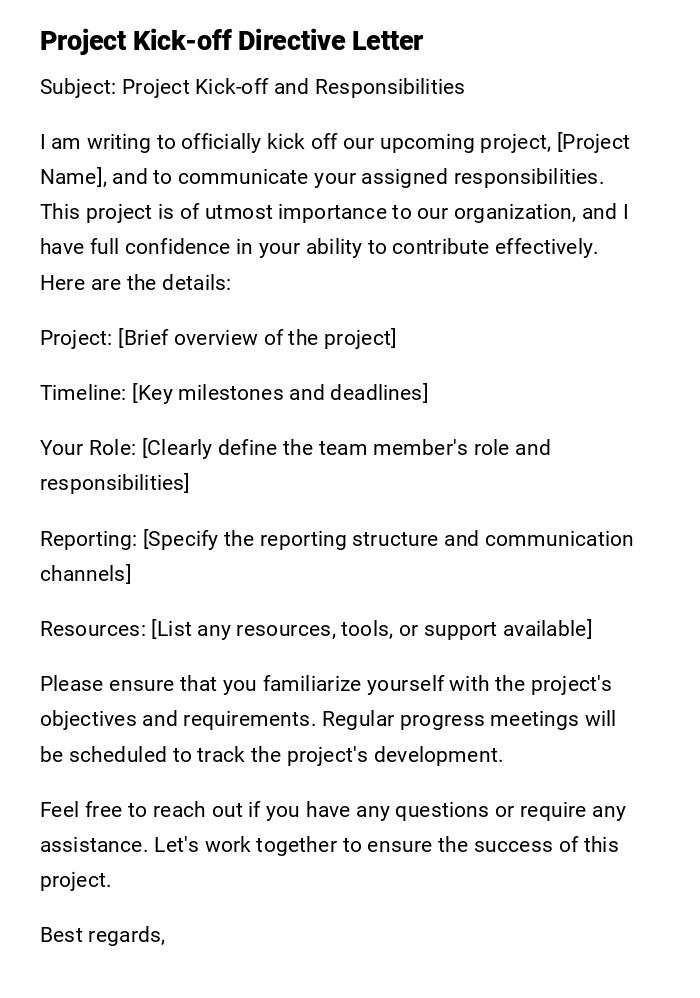
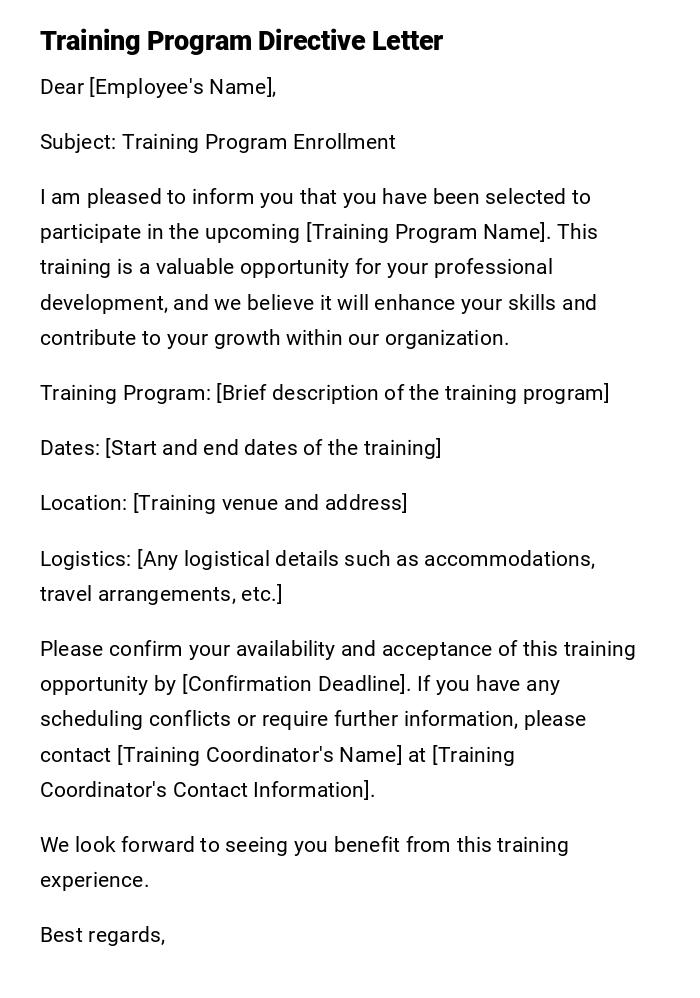
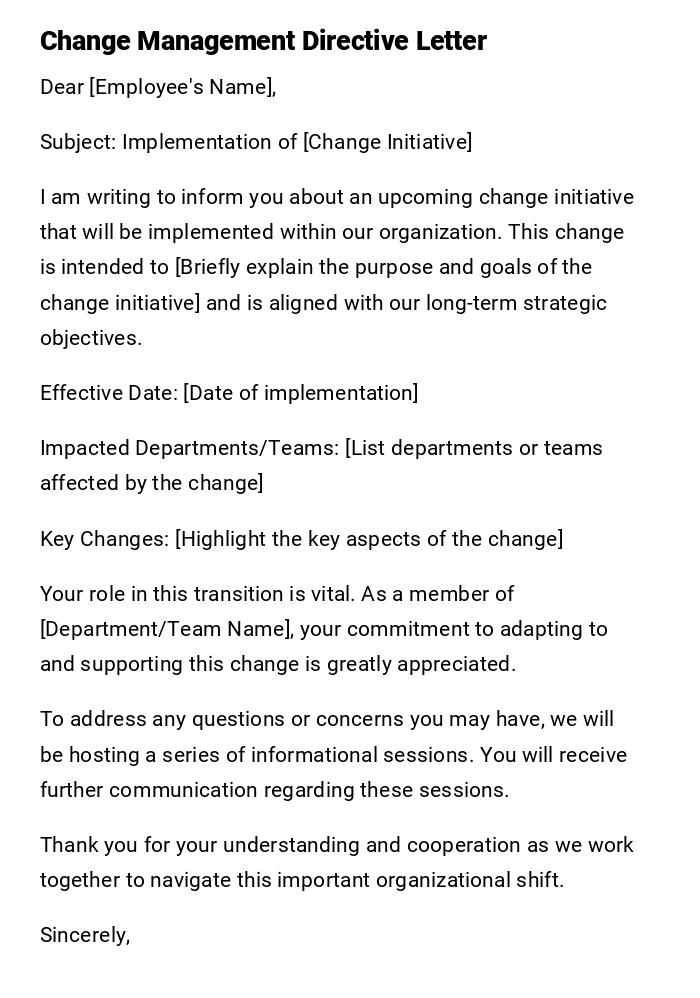
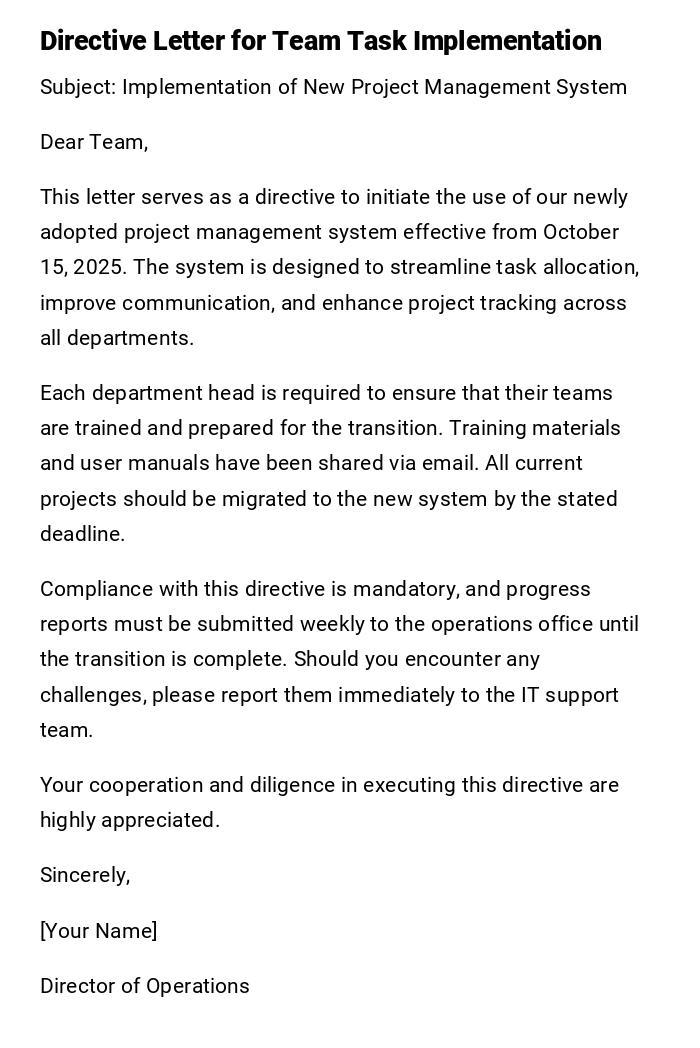
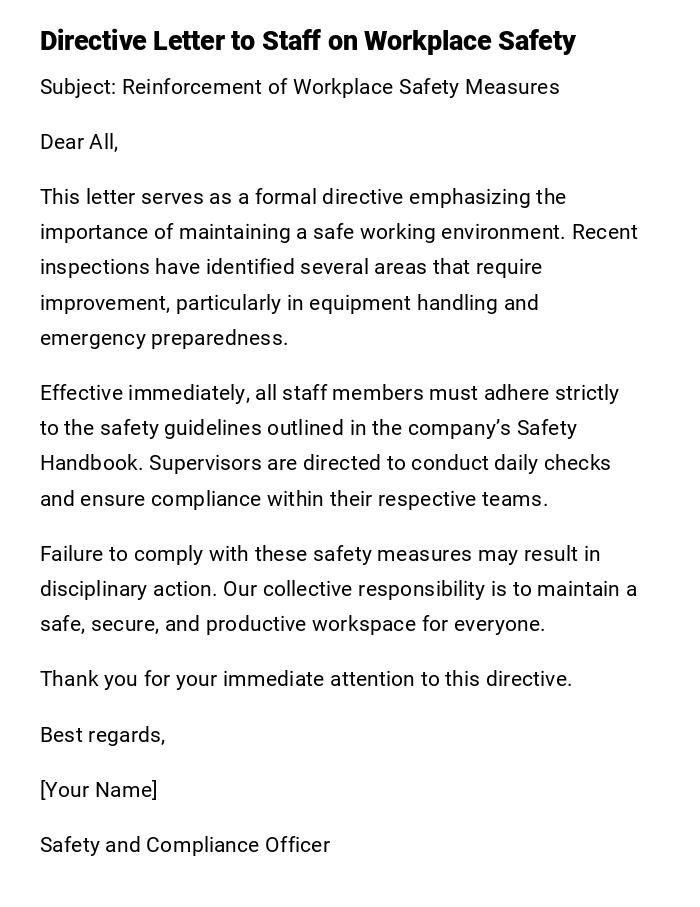
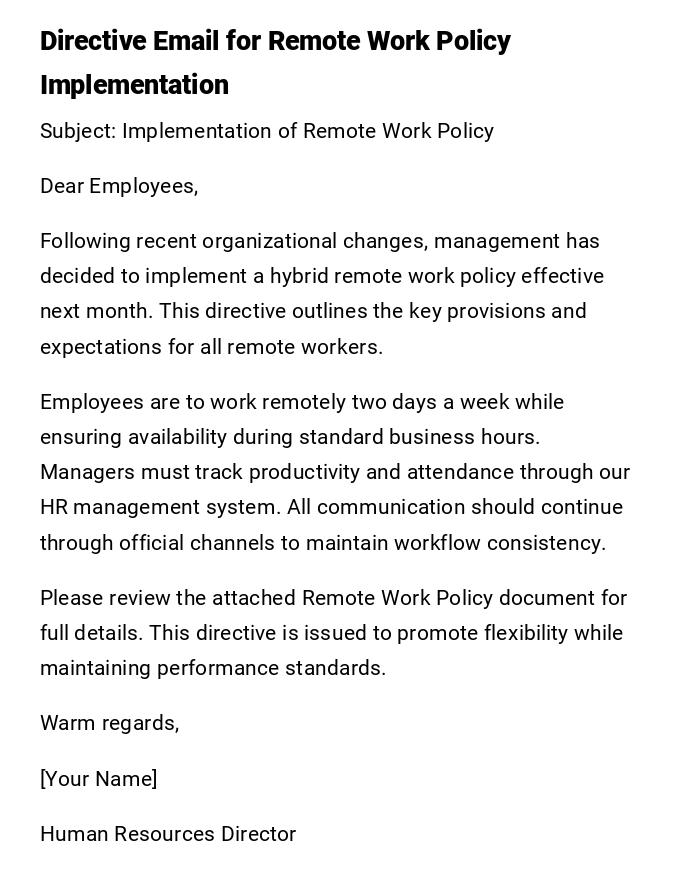
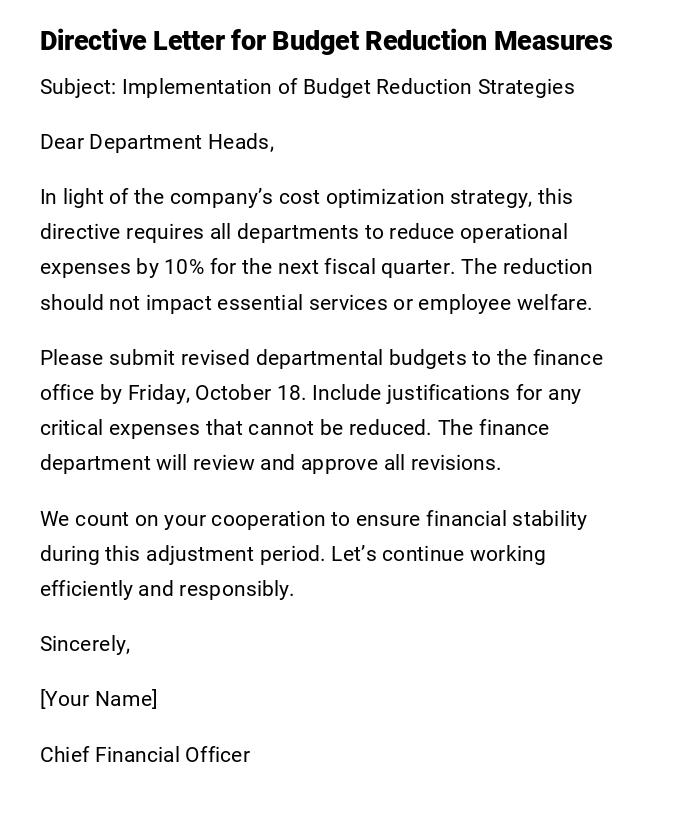
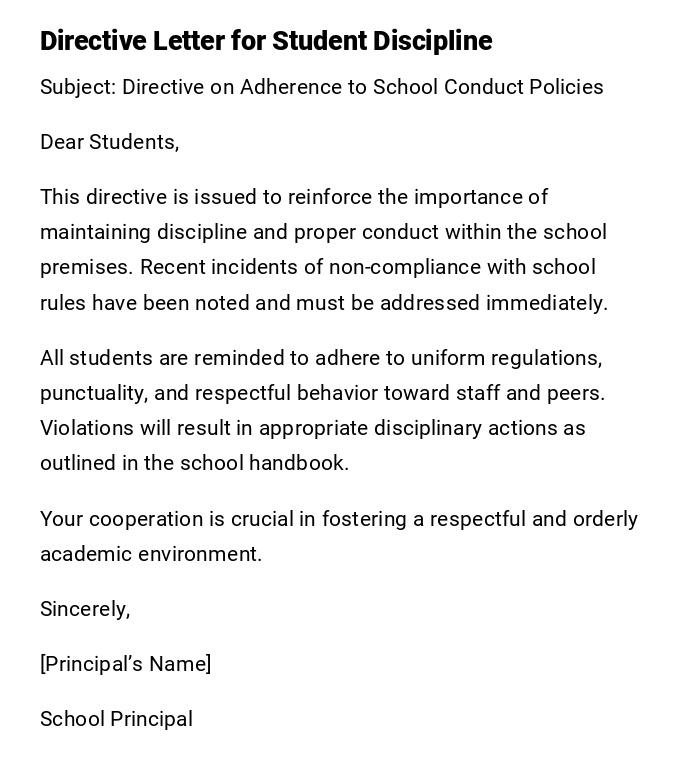
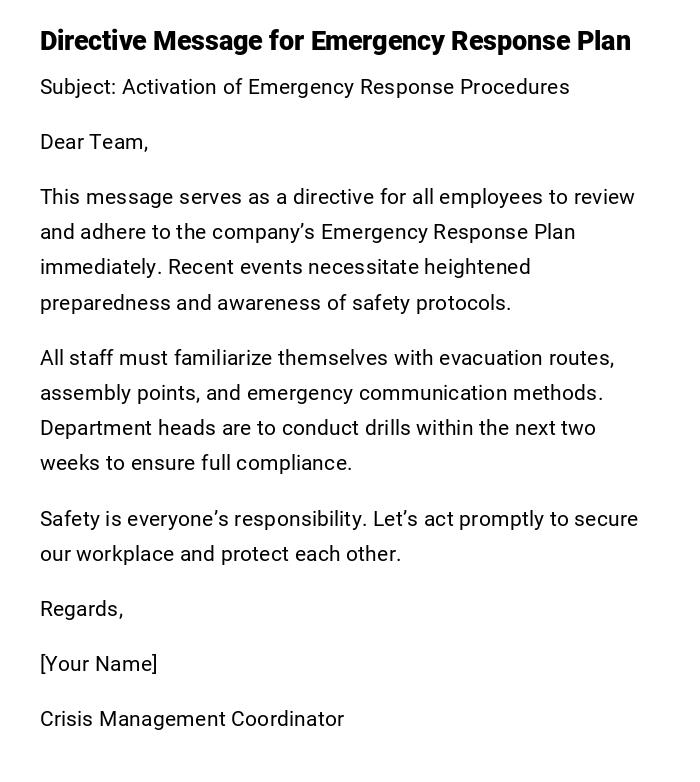
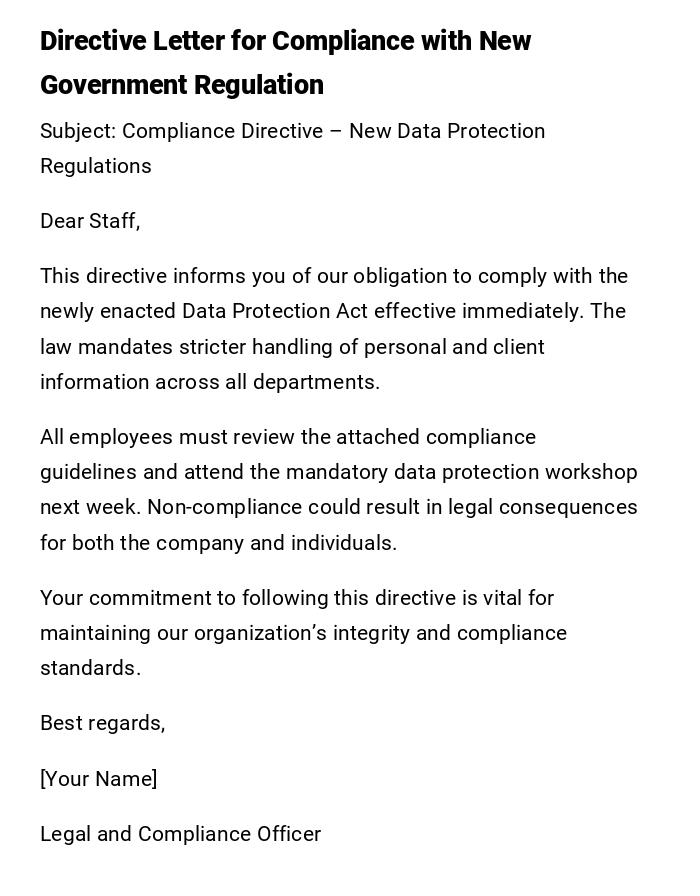
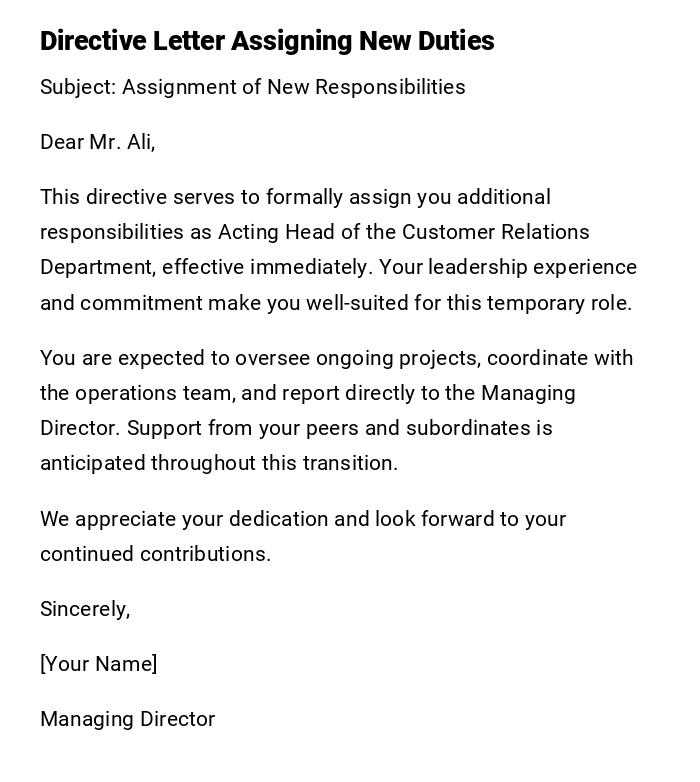

 Download Word Doc
Download Word Doc
 Download PDF
Download PDF